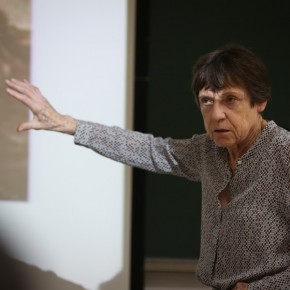
Held by the Department of Oil Painting of the School of Plastic Arts, CAFA, and presided over by Xie Dongming, Director of the Department of Oil Painting, Vice President of the School of Plastic Arts, “Beyond Aesthetics and Heritage Museum – The Never Explored Visual Potential”, a lecture by the famous French scholar Claude Imbert was held at F1 -109 amphitheater of Building 5.
Professor Claude Imbert is a known contemporary French philosopher and logician, Emeritus Professor of the Department of Philosophy of Ecole Normale Super Paris, has served as the dean of the Department of Philosophy, where she taught and presided over the courses of History of Philosophy, Logic and History of Logic, Aesthetics and Art Theory, Anthropology, Cognitive Science, etc. She has won a lot of awards, such as the French Academy of Moral and Political Sciences Academic Award, Knight Medal of the French Academy of Science, etc. respective publications including “Phenomenology and Formal Languages”, “As a Logical Defense: Plato’s Heritage”, “Merleau Ponty”, “Levi Strauss”, and so on.
As the lecture unfolded she focused of the following three parts: firstly, following Paul Klee, Merleau Ponty offered further distinguishing features of sight and visiblity, the liberation of vision today to explore a new vision, figurative or abstract, diverse production of images allowing the cultural heritage to move beyond the painting level, the boundaries of contemporary art, design and scientific charts are increasingly blurred. Furthermore, an emerging problem is of how to clearly grasp the process of modernity. Since the 19th century, this process has always been the characteristic of urban culture, new images are constantly produced and generate new meaning. Secondly, Cézanne and Manet as had a foothold to pursue the dimension relationships between the creation of visual angels and potential stimulation, such as Wittgenstein’s study of colored octahedral, Foucault’s discussion on the rights of the image, which gave evidence on the above issues. Thirdly, in contrary to the traditional visual angle, through the works of Rothko and Mondrian, the cognition without determinism, as well as the impact on the trajectory of contemporary anthropology which can be detected, from this perspective, art history, cultural exchanges, and contemporary cultural production changes our way of seeing.
Professor Imbert initially explained how to move beyond the classical paradigm in these fields except for the traditional aesthetics and art. There are two roles of the exhibition: firstly, temporarily it should focus on displaying the works, protected by the museum; secondly, the exhibition is not only for artworks but also visual education. Several iconic works are emerging in the field of painting, they have illustrated the changes of visual focus - color. Professor Imbert explained these works, including Theodore Gericault’s “Raft of the Medusa”, Delacroix’s “Liberty Leading the People” and “Algiers Women”, Manet’s “Gare Saint Lazare”, “Balcony”, “Opera Dance”, “Luncheon on the Grass”, and “Un bar aux Folies Bergère”, for the audience with the aid of slides.
Through the interpretation of Cezanne’s “Black Clock”, Imbert revealed how the viewer’s attention’s shifts from aesthesis to a new visual dimension - emotional effect, with this conversion of perspective, the viewer and painter have a closer relationship, “visible visual” is not only visual, but also oriented outwards. From the reproducibility of Manet to Cézanne’s diagram-like paintings, and Mondrian’s grid paintings are illustrated so that the viewer gradually changes simple aesthetic images of “beautiful or not”, to an endless conquest.
Finally, Imbert told a story: After going to the Louvre to copy paintings, the American Morse created the Morse code on the ship during his return to America, reflecting that Morse understood paintings as visual information instead of a reproduction of things. Imbert said, currently drawings are more and more used as the material of anthropologists, because paintings are related to the visual education. In the natural science, the use of charts to convey visual information reflects the vision that has gone beyond the difference between natural sciences and humanities.
Journalist: Duan Ziying, Photo: Hu Zhiheng /CAFA ART INFO
Translated by Chen Peihua and edited by Sue/CAFA ART INFO





































